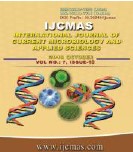


 National Academy of Agricultural Sciences (NAAS)
National Academy of Agricultural Sciences (NAAS)

|
PRINT ISSN : 2319-7692
Online ISSN : 2319-7706 Issues : 12 per year Publisher : Excellent Publishers Email : editorijcmas@gmail.com / submit@ijcmas.com Editor-in-chief: Dr.M.Prakash Index Copernicus ICV 2018: 95.39 NAAS RATING 2020: 5.38 |
A field experiment with cowpea was conducted in a sandy loam soil, in the Eastern Dry Zone (Zone 5) of Karnataka to evaluate the residual effect of enzyme industrial waste-municipal solid waste composts on growth, yield and nutrient uptake of cowpea during 2014 following a maize crop. The results revealed that the plant height (80.93 cm), number of branches (8.18), yields of cowpea (765.67 kg ha-1) and biomass (1806.97 kg ha-1) were higher in treatment T9 (50 % N through PS + 50 % N through FYM) indicating the residual effect. The application of enzyme industrial waste-municipal solid waste composts viz. T6 (MEES compost @ 10 t ha-1) and T7 (PS compost @ 10 t ha-1) recorded similar plant height, number of branches and cowpea yields of 526.50 and 654.33 kg ha-1 and haulm yields of 1289.93 and 1570.40 kg ha-1 respectively. Application of 100%NPK +FYM @ 5 t ha-1 resulted in lesser growth, yield, nutrient concentration and uptake by cowpea. Application of enzyme industrial waste- municipal solid waste composts resulted in similar concentration of nutrients in cowpea, haulm and their uptake indicating an on par performance revealing their suitability as organic nutrient source for use in agriculture.
 |
 |
 |
 |
 |